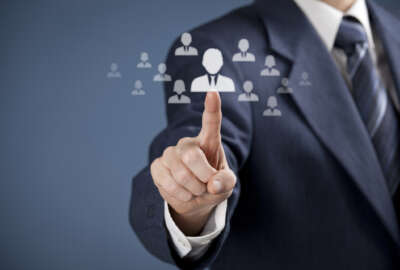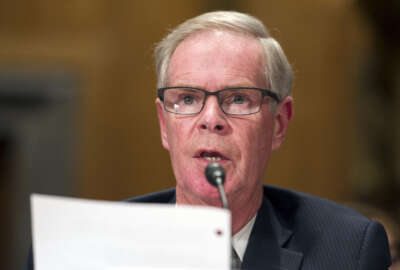
A possible solution to the shared services funding problem emerges
The Unified Shared Services Management Office at GSA released a new 10-year vision for federal back-office shared services that relies on a subscription or...
Shared services have hit a brick wall. Office of Management and Budget and General Services Administration leaders say without a new source of funding, it could take decades to move agencies off of legacy back-offices systems and on to new shared platforms.
That’s why the Unified Shared Services Management Office at GSA is evolving its vision to overcome this funding challenge.
Beth Angerman, the executive director of the Unified Shared Services Management Office, said this new 10-year approach will give agencies an opportunity to modernize financial, human resources and other systems without the huge upfront cost.
“We need to reduce the risk of the legacy IT systems and that includes the legacy IT systems that are currently run by our shared services providers today. So we are making a statement that says we are moving administrative systems to software-as-a-service,” Angerman said in an interview with Federal News Radio after speaking at a shared services event sponsored by FCW in Washington on Dec. 7. “This really is an opportunity for industry and the software vendors to think about how they would deliver software-as-a-service, which is very different from what the government has been doing over the last many decades around how we actually use systems to support these mission support functions.”
Angerman compared the change to how tax preparers change their software every year to meet changing requirements.
“Every year when you log into that website, you get the most recent tax code rules, you get the most recent innovation and you get the best technology. That is the type of scenario we want to set up for how we, as a government, buy systems going forward,” she said. “That then forces us to think differently about how we deliver services, and we believe in the future vision we need to more opportunity for the create distinction between industry delivering software-as-a-service, federal providers being able to use their skills and the people that they have to have economies of scale and economics of skill, and then opportunities for industry to compete with that so that we really can get the best cost for the consumer.”
A subscription based or software-as-a-service model will give the government the flexibility, predictability and should eliminate costly spikes, she added.
“We aren’t buying the license any more. Hopefully we will be partnering with industry to buy what we actually use—more of a utility,” Angerman said. “The current model we are going to hit a brick wall very soon. If we shift to the future visions, and we put the burden of defining what is common on the government, then we have sorts of opportunities for delivering on that.”
That definition of what’s common is a second key piece of the vision.
The USSM is working through its governance structure to come to a common agreement across the financial or human resources or other back-office administrative functions sector on business processes, capabilities and data.
“We will never really achieve economies of scale if we don’t agree on what we are commonly buying. We have to turn into a utility and we haven’t done that yet,” Angerman said. “Having a shared service provider that has to accommodate everyone’s needs isn’t going to add the benefits we are currently looking for.”
The Human Resources Line of Business has been moving down the path toward creating common definitions for the past two years.
David Vargas, the director of the Human Resources Line of Business for the Office of Personnel Management, said his team has standardized across three major areas — time and attendance, performance management and talent development — and several others are in the works.
“It’s important for us to speak the same language. Right now we do not speak the same language,” he said. “With the understanding that no two agencies are the same and there will be differences among the agencies that we have to manage for, but those commonalities are important for us to capture and drive our technology to meet those minimum baseline standards.”
In some ways, the HR LOB already is moving toward this subscription based model. Since 2012, the Veterans Affairs Department has been working with IBM to implement a new HR system-as-a-service.
Timothy Newman, the associate deputy assistant secretary for HR Systems and Analytics in VA’s Human Resources and Administration, said VA began implementing new human resources services in 2015 and now more than 347,000 employees are using the technology.
“IBM handles all the technology investment and we provide a service agreement so it’s somewhat of a SaaS-type model but more of a service agreement model,” he said. “We provide a reoccurring set of operations and maintenance costs so we know what our price points are every year and we can leverage the modernization of technology. We can move from an antiquated system and stay on the current path moving forward from that point forward.”
Newman said VA needed to make sure it had a long-term solution where it could get off its legacy system and then expand to a multi-year technology system.
GSA recently signed a similar deal with IBM for HR systems and services.
Angerman said over the last few years, the realization by the Office of Management and Budget, the shared service providers and federal CXOs that shared services had grown too widespread and lost some of its initial focus led to the new vision.
For this reason, OMB launched USSM, developed the modernization and migration management (M3) framework and created a playbook for agencies earlier this year as the first steps toward the as-a-service model.
“There were two ‘a-ha moments’ over time. One is funding. Everyone agrees that this is the right thing to do, but there’s less recognition that you have to pay to get there and make the investment to realize the long-term benefits,” she said. “It’s really difficult, especially in times like now, we want to make the investment in mission. This model helps us think differently about how we can make those investments and partner with industry. Everyone has been saying for a long time that we need to think more strategically about how industry can introduce capital, and this gives us now an opportunity to do that.”
The second ‘a-ha’ moment came around the need to standardize business processes and data definitions.
But really the success or failure of shared services does come back to funding. The federal providers need capital to upgrade and expand their offerings, but can’t do that without help from Congress.
OMB hasn’t promoted the use of private sector providers over the last few years, but that is changing now with the new vision.
Angerman said the USSM is looking at how best to implement a subscription or as-a-service approach.
“I want to work closely with industry to figure out how this works, and what the government needs to do to make software-as-a-service be effective for the government. Change management becomes really important; new legislation and new requirements, things that impact what we do in these systems and how deliver this needs to be coordinated and the managing partners will be doing that,” she said. “That all really contributes to not only the procurement strategy, but the operating model.”
Copyright © 2025 Federal News Network. All rights reserved. This website is not intended for users located within the European Economic Area.
Jason Miller is executive editor of Federal News Network and directs news coverage on the people, policy and programs of the federal government.
Follow @jmillerWFED
Related Stories

What message does GSA’s decision to outsource its HR systems send to rest of government?





